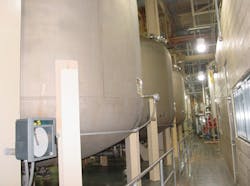Global beverage company achieves environmental targets
By James Laughlin, Industrial WaterWorld Editor
Staff at Anheuser-Busch InBev facilities around the world have focused on reducing their use of water and energy, while also reducing carbon emissions. Part of that process was to identify and analyze each process stream to determine how best to reduce or recover renewable resources.
As a result, the company has achieved global environmental goals to reduce the company's impact on the environment. The goals, part of a three-year program, were achieved through a multi-faceted approach that applied a mix of operational changes, technological solutions, partnerships and teamwork among 118,000 employees around the world. The goals involved 130 breweries and soft drink facilities across more than 20 countries.
Leading the way, the Cartersville brewery in Georgia was able to reduce water usage to 2.8 hectoliters of water per hectoliter of production (one hectoliter = 26.417 gallons). The facility's efforts had a significant impact in achieving the 17.5% decrease in water use that U.S. breweries achieved between 2009 and 2012. The reduction helped save the equivalent of 10.2 billion liters of water.
On average worldwide, the company was able to reduce water usage to 3.5 hectoliters of water per hectoliter of production within a three-year period. That represented an 18.6% reduction in water usage across AB InBev's global operations. That is equivalent to the amount of water needed to produce approximately 25 billion cans of beer and soft drinks, which is about 20% of one year's production.
"The key factor that led to our global water reductions has been our brewery operations management system, Voyager Plant Optimization (VPO)," said Bert Share, Senior Global Director for Beer and Better World at Anheuser-Busch InBev. "VPO includes rigorous standards for sustainability, operations, quality and safety outcomes.
"This is the framework we use to benchmark natural resource usage, quantify performance gaps, identify and disseminate best practices, develop action plans at regional and brewery levels, support sites with individual three-year plans that include challenging usage targets and conduct disciplined monthly reviews to monitor progress," he said.
Management at the Cartersville facility established a cross-functional water conservation team to implement best conservation practices. The team's goal was to engage employees at all levels, while maintaining strict quality and efficiency standards. The team pioneered several initiatives to reduce water usage, including weekly "Water Walks" around the brewery to identify areas where performance could be improved.
"We consciously decided to prioritize water reduction as a critical initiative for the brewery," said Rob Haas, General Manager, Cartersville Brewery. "The entire brewery team has been engaged in this effort, supported by our colleagues throughout North America and the world who have been champions for the company's Better World efforts and have challenged all breweries to share tips and best practices globally."
Water reuse played a key role in helping reduce overall consumption. Reuse applications at Cartersville included collecting carbon filter water and reusing it in the evaporative condensers. Equipment cooling water was also reused, and rinser reclaim water was used for utilities makeup water.
While Cartersville achieved the lowest net water use, breweries in China saw the biggest reductions in water use. In the three-year program, Chinese breweries reduced water use by 38.4% and energy use by 30%.
Similar to Cartersville, the Chinese breweries developed a "challenge all drains" initiative, which required every functional department of a facility to identify and analyze each water flow stream being sent to the drain and to find ways to reduce it or recover it.
"This simple visibility engaged all water users in the breweries and enabled us to identify multiple opportunities for optimization," Share said.
In addition to water use reductions during the three-year environmental program, Anheuser-Busch InBev was able to reduce energy use per hectoliter in breweries and soft drink facilities worldwide by 12%. It also reduced carbon emissions by 15.7% and increased its recycling rate to 99.2% for solid waste and byproducts, passing its original three-year target of achieving a 99% recycling rate.
While achieving its environmental goals, the program also helped to identify new revenue streams, generated savings and spurred the involvement of more employees and partners in AB InBev's sustainability initiatives. Recycling helped generate approximately $420 million in revenues globally from finding beneficial uses for various materials generated from the company's processes. Efforts to use water and energy more efficiently also generated an estimated global cost savings of $92 million.

